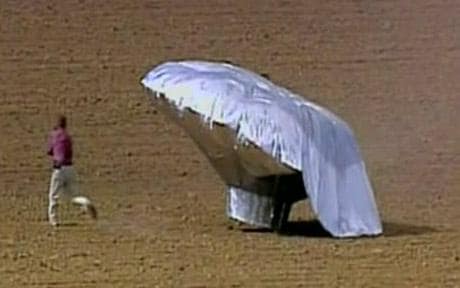By M. Mallon
On October 15, 2009, the United States watched with baited breath as a partially deflated weather balloon careened 10,000 feet in the air above Colorado, the National Guard with helicopters in hot pursuit. The catalyst for this remarkably large operation was the widespread belief that 6 year old Falcon Heene was trapped inside, having crawled in before it was set loose from his backyard. The boy’s parents, Mayumi and Richard Heene, had alerted authorities that he was missing, but that the boy’s two brothers had seen him climb into a compartment of the balloon prior to it breaking loose from restraints. The frantic family’s story sparked the beginning of a three hour chase which affected flights from the nearby Denver airport and involved a massive task force of officials as they attempted to save Falcon, both on foot and in aircrafts. When the balloon gently came to rest in a field some 60 miles from its origin, officials and onlookers were baffled to find that the 6 year old was not inside.
Not long after the balloon’s descent, the Heenes discovered Falcon hiding in their garage. This provided a relieving but perplexing ending to the saga. Millions of onlookers had tuned in to live broadcasting of the sensational event as it unfolded over the course of only a few hours, eager to follow the evolving story. Unsurprisingly, the bizarre story attracted a range of theories about the boy’s whereabouts and condition. Some claimed he had climbed into a box hanging beneath the balloon which had since fallen off. Others were sure he would not survive the altitude or landing. The possibility of shooting down the balloon was suggested. Some were quick to call the entire affair a publicity stunt.
The perplexingly simple resolution to this spectacle then gave way to scrutiny aimed at Falcon’s parents as their version of the fiasco began to unravel under the public eye. As the public began suspecting a hoax, the family’s history of attention seeking was laid bare. An investigation revealed that they had attempted to launch multiple reality shows and had been featured twice on the show “Wife Swap.” Then, in a live interview, a CNN interviewer asked Falcon why he remained hidden for so long and he replied “You guys said that we did this for a show.” This comment sparked the collapse of the entire story. The family’s history with fame seeking and eagerness to work with reporters and media outlets despite claims that they wished to put the debacle behind them incited suspicion. It was later confirmed by Mayumi Heene that the stunt was a fame-seeking hoax. The couple pleaded guilty in court to charges of influencing public servants and filing a false report.
In hindsight, it is easy to question how such a crudely devised stunt had deceived news sources, viewers, and authorities. But the widespread confusion cannot be completely attributed to the Heene’s ability to deceive. In fact, the Heene’s narrative was one of the weakest forces involved in the virality of the story, given that its integrity relied on the consistency of their 6-year old son’s word and their wholly unconvincing acting skills. Instead, the infamous bamboozle, quickly dubbed the “balloon boy hoax,” achieved such instant media success because it appealed to the audience’s desire to be influential in the establishment of widespread discourse. The lack of definitive answers and eagerness of media to be the first ones covering the story meant that millions of people were devouring every vague detail of a story which relied on the word of three children. People delight in this kind of chaotic information because unexplained and quickly reported events give the viewer the freedom to insert their own perspective into the narrative.
It is this overwhelming accessibility of information that likely drove the Heenes to such drastic measures in their search for fame. These attention seekers sought not to make their story available, but to create one so sensational that the public could not look away. And so the Heenes sought to capture the focus of the country by involving the media, another participant in the constant search for a story powerful enough to monopolize national attention. Their previous stints on reality television had led to dead ends, so the serial exibitionists turned to the only form of publicising themselves with the power to dominate such a limited reserve of attention: fabricating an emergency so dire and perplexing that national news outlets would clamber to broadcast it.
While information is abundant, the public only has so much attention to give. The attention economy has become a lucrative business, and the balloon boy hoax allowed both the Heenes and the media to harness this limited resource. To the Heenes, the hoax’s success meant fame and a career in reality television. To news outlets it meant increased viewership. For both, attention provided the potential for for profit. Amid a constant barrage of dramatized content, news with the power to captivate an increasingly distracted audience has become an invaluable commodity.
